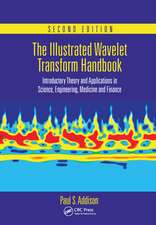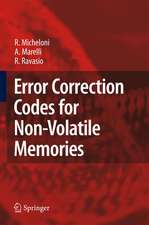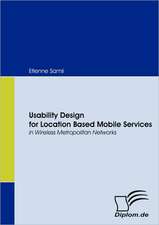Emerging Wireless Networks: Concepts, Techniques and Applications
Editat de Christian Makaya, Samuel Pierreen Limba Engleză Paperback – 13 iun 2017
The book begins by appraising the management challenges in emerging wireless networks. It examines the state-of-the-art in mobility management for IP-based mobile networks, at both the network and link layers. Proposing an integrated network architecture design for NGWNs—including wireless local, metropolitan, and wide area networks—it analyzes WLAN/3G network convergence and advanced mobility features based on the IP Multimedia Subsystem (IMS) architecture. It highlights the challenges and issues related to mobile virtual private networks, and also:
- Examines the emerging mobile broadband wireless standards such as IEEE 802.16 and LTE
- Introduces a mechanism that provides service continuity to end-users in self-organizing IP Multimedia Subsystem environments
- Considers the challenges, solutions, and services of vehicular communication networks
- Unveils a new transmission paradigm (network coding) to improve the performance of the transmission control protocol.
Preț: 397.37 lei
Preț vechi: 591.73 lei
-33% Nou
Puncte Express: 596
Preț estimativ în valută:
76.04€ • 79.23$ • 62.96£
76.04€ • 79.23$ • 62.96£
Carte tipărită la comandă
Livrare economică 03-17 aprilie
Preluare comenzi: 021 569.72.76
Specificații
ISBN-13: 9781138111745
ISBN-10: 1138111740
Pagini: 444
Ilustrații: 172
Dimensiuni: 156 x 234 x 34 mm
Greutate: 0.45 kg
Ediția:1
Editura: CRC Press
Colecția CRC Press
Locul publicării:Boca Raton, United States
ISBN-10: 1138111740
Pagini: 444
Ilustrații: 172
Dimensiuni: 156 x 234 x 34 mm
Greutate: 0.45 kg
Ediția:1
Editura: CRC Press
Colecția CRC Press
Locul publicării:Boca Raton, United States
Public țintă
Professional Practice & DevelopmentCuprins
MOBILITY MANAGEMENT AND NETWORKS CONVERGENCE. Management Challenges for Emerging Wireless Networks. Mobility Management for All-IP Mobile Networks. Integrated Network Architecture Design for Next-Generation Wireless Systems. WLAN/3G Convergence and Advanced Mobility Features. CROSS-LAYER DESIGN AND SESSION CONTINUITY. Mobile VPNs Architectures: Challenges and Issues. Cross-Layer Handover for Mobile WiMAX Networks. Service Continuity Support in Self-Organizing IMS Networks. Vehicular Communication Networks – Challenges, Solutions and Services. RESOURCE MANAGEMENT AND COGNITIVE NETWORKS. Network Coding Approach to Improve TCP Throughput in Wireless Networks. Network Selection and Spectrum Sharing for Cognitive Radio Systems. Network Selection and Congestion Avoidance Control. Efficient Spectrum Band Packing for Hosting Multiple Wireless Systems.
Notă biografică
Christian Makaya is a senior research scientist in Advanced Technology Solutions, at Telcordia Technologies. He received a Ph.D. degree in computer engineering from the Ecole Polytechnique de Montreal, University of Montreal, Canada in 2007. Prior to joining Telcordia, he was a research fellow and a lecturer within the Department of Computer Engineering of the Ecole Polytechnique de Montreal. He also held a position as principal architect and senior scientist for a start-up consulting firm in Montreal, where he led research and development (R&D) activities in the area of advanced wireless networking technologies and software development.
Dr. Makaya has served as a reviewer for numerous international journals, and as a program committee member of several workshops and conferences. The focus of his research interests is on wireless networking and mobile computing, which includes, but not limited to: radio resource management, interworking architectures design, mobility management, performance evaluation, network planning, machine-to-machine communications, IP multimedia subsystem, cloud computing, self-organizing networks, and open source mobile platforms implementation. Dr Makaya has authored numerous technical papers (in journals, conferences and workshops) and book chapters.
Samuel Pierre received his B.Eng. degree in civil engineering in 1981 from Ecole Polytechnique de Montreal, Quebec, Canada, B.Sc. and M.Sc. degrees in mathematics and computer science in 1984 and 1985, respectively, from the UQAM, Montreal, a M.Sc. degree in economics in 1987 from the University of Montreal, and a Ph.D. degree in electrical engineering in 1991 from the Ecole Polytechnique de Montreal. He is currently a Professor of Computer Engineering at Ecole Polytechnique de Montreal, University of Montreal, where he is Director of the Mobile Computing and Networking Research Laboratory (LARIM), Chairholder of the NSERC/Ericsson Chair in Next Generations and Mobile Networking Systems. His research interests include wireline and wireless networks, mobile computing, artificial intelligence, and tele-learning.
From 1987 to 1998, he was a Professor at the University of Quebec at Trois-Rivieres prior to joining the TeleUniversite of Quebec, an Adjunct Professor at Universite Laval, Ste-Foy, Quebec, an Invited Professor at the Swiss Federal Institute of Technology, Lausanne, Switzerland, and the University Paris 7, France. Dr. Pierre has received several distinctions such as the Prix Poly 1873 for excellence in teaching (2001 and 2005), Fellow of the Engineering Institute of Canada (EIC) in 2003. He is Fellow of Canadian Academy of Engineering (2008). Dr. Pierre serves on editorial board of several international journals as well as general chair or technical program committee member of various conferences.
Dr. Makaya has served as a reviewer for numerous international journals, and as a program committee member of several workshops and conferences. The focus of his research interests is on wireless networking and mobile computing, which includes, but not limited to: radio resource management, interworking architectures design, mobility management, performance evaluation, network planning, machine-to-machine communications, IP multimedia subsystem, cloud computing, self-organizing networks, and open source mobile platforms implementation. Dr Makaya has authored numerous technical papers (in journals, conferences and workshops) and book chapters.
Samuel Pierre received his B.Eng. degree in civil engineering in 1981 from Ecole Polytechnique de Montreal, Quebec, Canada, B.Sc. and M.Sc. degrees in mathematics and computer science in 1984 and 1985, respectively, from the UQAM, Montreal, a M.Sc. degree in economics in 1987 from the University of Montreal, and a Ph.D. degree in electrical engineering in 1991 from the Ecole Polytechnique de Montreal. He is currently a Professor of Computer Engineering at Ecole Polytechnique de Montreal, University of Montreal, where he is Director of the Mobile Computing and Networking Research Laboratory (LARIM), Chairholder of the NSERC/Ericsson Chair in Next Generations and Mobile Networking Systems. His research interests include wireline and wireless networks, mobile computing, artificial intelligence, and tele-learning.
From 1987 to 1998, he was a Professor at the University of Quebec at Trois-Rivieres prior to joining the TeleUniversite of Quebec, an Adjunct Professor at Universite Laval, Ste-Foy, Quebec, an Invited Professor at the Swiss Federal Institute of Technology, Lausanne, Switzerland, and the University Paris 7, France. Dr. Pierre has received several distinctions such as the Prix Poly 1873 for excellence in teaching (2001 and 2005), Fellow of the Engineering Institute of Canada (EIC) in 2003. He is Fellow of Canadian Academy of Engineering (2008). Dr. Pierre serves on editorial board of several international journals as well as general chair or technical program committee member of various conferences.
Descriere
An authoritative collection of research papers and surveys, this book explores recent developments in next-generation wireless networks (NGWNs) and mobile broadband networks technologies. Focusing on improving the performance of wireless networks and provisioning better quality of service and quality of experience for users, it reports on the standards of different emerging wireless networks, applications, and service frameworks. Proposing an integrated network architecture design for NGWNs, it analyzes WLAN/3G network convergence and advanced mobility features based on the IP Multimedia Subsystem (IMS) architecture.



















